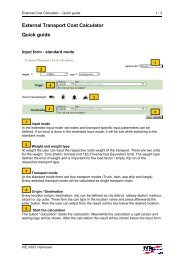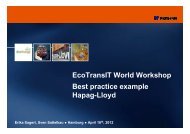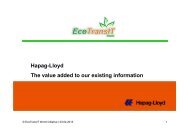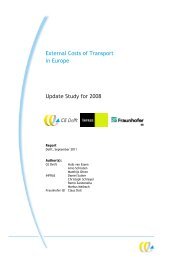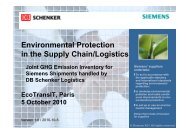Verena Ehrler - EcoTransIT
Verena Ehrler - EcoTransIT
Verena Ehrler - EcoTransIT
You also want an ePaper? Increase the reach of your titles
YUMPU automatically turns print PDFs into web optimized ePapers that Google loves.
How to align different<br />
methodologies for carbon<br />
calculation globally –<br />
the COFRET-project<br />
Dr.-Ing. <strong>Verena</strong> <strong>Ehrler</strong><br />
DLR Institute of Transport Research
COFRET is a collaborative research and demonstration project<br />
part-funded by the European Commission,<br />
which will deliver a methodology for the calculation<br />
of the carbon footprint along the full supply chain<br />
COFRET Objectives are to<br />
establish a complete GHG emission calculation methodology and framework<br />
in the context of complex supply chains based on available calculation tools<br />
for CO 2<br />
emissions<br />
cover all types of shipments at company level and aggregated level of<br />
transport and logistics<br />
provide a methodology that is applicable for supply chains within the EU as<br />
well as in the global context<br />
embed practical exploitation as a key element of the technical work<br />
programme to maximise the eventual
Approach of the project<br />
work with the existing initiatives - close co-operation between the COFRET<br />
team and industry stakeholders<br />
develop a comprehensive methodology to be used in in-house and<br />
commercial applications<br />
test the methodology in real supply chain applications<br />
work to maximise the eventual uptake of the COFRET methodology
Project structure
Project partners<br />
• DLR (Germany)<br />
• IFSTTAR (France)<br />
• RAPP Transport (Switzerland)<br />
• VTT (Finland)<br />
• PTV (Germany)<br />
• TU Dortmund (Germany)<br />
• HIT Certh (Greece)<br />
• TTR (UK)<br />
• TNO (The Netherlands)<br />
• NEA (The Netherlands)<br />
• Marlo Consultants (Germany, Norway)<br />
• TOI (Norway)<br />
• FVGT (Lithuania)<br />
• IST (Poland)
Project Advisory Board<br />
• Connekt (The Netherlands)<br />
• Deutsche Bahn (Germany)<br />
• DHL (Germany)<br />
• Ewals Cargo (The Netherlands)<br />
• Fiege AG (Germany)<br />
• Kühne & Nagel (UK)<br />
• Maersk Line (Denmark)<br />
• Myclimate (Switzerland)<br />
• NTM (Scandinavia)<br />
• Sainsbury‘s (UK)<br />
• Swiss WorldCargo (Switzerland)<br />
• UPM (Finland)
Step 1: Review of existing resources and user needs<br />
State-of-the-art study to support COFRET methodology development<br />
The main tasks: identify, review and assess<br />
• existing methods, tools and databases<br />
• user needs, practices and experiences<br />
• future technologies and innovations<br />
in the context of freight transport carbon footprint calculation
Step 2: Assessment of existing methods, tools and<br />
databases<br />
A total of 102 objects were identified as relevant to the COFRET project.<br />
Review and assessment was carried out using a structured review template.<br />
Four types of objects:<br />
carbon footprint methodologies<br />
carbon footprint calculation tools<br />
emission factor databases<br />
other activities and initiatives.<br />
Assessment criteria:<br />
• transport modes, vehicles and equipment covered<br />
• supply chain elements and logistics operations covered<br />
• emission compounds and life cycle phases covered<br />
• geographical and methodological approaches and data sources used, etc.
Step 3: Analysis of user needs, practices and experiences<br />
Methodology applied: combination of<br />
• in-depth interviews (29 interviews)<br />
• on-line survey (62 answers)<br />
• stakeholder workshop (17 participants) in Berlin January 2012.<br />
Stakeholders involved include:<br />
transport and terminal operators, logistics service providers, manufacturers,<br />
wholesalers, retailers and consumers, researchers and policy makers.<br />
Topics covered:<br />
• motivations to calculate carbon footprint<br />
• current practices in regards to use of calculation tools and results<br />
• current shortcomings<br />
• future needs and expectations, etc.
Step 4: Future technologies and innovations<br />
Review of potential solutions to improve measurement or calculation of carbon<br />
footprint.<br />
Focus on future technology development and system integration opportunities<br />
with carbon footprinting.<br />
Three main areas of interest:<br />
• supply chain and transport planning systems<br />
(e.g. multimodal routing systems)<br />
• information and communication systems<br />
(e.g. positioning and internal vehicle systems)<br />
• business applications<br />
(e.g. enterprise resource planning and fleet management systems).
Conclusions to be drawn from the state-of-the-art review<br />
so far<br />
up-to-date knowledge-base of existing methods, tools and databases: consistent<br />
but vague methodological base, wide variability and fragmentation in tools and data<br />
identification of the most relevant methods, tools and databases from the<br />
COFRET point of view<br />
clarified user needs: strong pull for harmonisation<br />
potential to employ future technology systems identified<br />
confirmation of the COFRET objectives (methodology to cover all transport and<br />
logistics along the supply chain)<br />
cooperation with stakeholders and parallel development activities established
COFRET - Next steps<br />
catering to user needs and expectations: balancing<br />
simplicity ↔ flexibility ↔ accuracy<br />
cooperation around best available methods, tools and databases, as well as<br />
technology systems<br />
compliance with leading standards and programmes<br />
numerous technical details to be investigated: application areas, inputs & outputs,<br />
allocation, time averaging, data acquisition, system boundaries, uncertainties, etc.<br />
involvement of all relevant actors along the supply chain.
COFRET deliverables up to date:<br />
Deliverable 2.1: Existing methods and tools for calculation of carbon footprint of<br />
transport and logistics<br />
Deliverable 2.2: User needs, practices and experiences in the context of carbon<br />
footprint calculations in supply chain configurations<br />
Deliverable 2.3: Future technologies and innovations relating to freight transport<br />
which are relevant for carbon footprint calculation<br />
Deliverable 2.4: Methodologies for emission calculations - Best practices,<br />
implications and future needs (SUMMARY REPORT)<br />
To be available at the COFRET website http://www.cofret-project.eu
Scope of the COFRET-project<br />
COFRET's main objective is to develop and test a methodology for the accurate<br />
calculation of carbon footprint of transport and logistics in the context of supply<br />
chains. COFRET provides a methodology to calculate CO2 emissions and if applicable further<br />
greenhouse gases (GHGs) such as CH4 and N2O as well as so-called F-gases deriving from<br />
cooling processes.<br />
COFRET assesses currently available methodologies and tools and provides solutions<br />
for gaps. All supply chains can be constructed using supply chain elements (SCEs). SCEs are<br />
for example FTL road transport, distribution routes, transhipment processes, storage and order<br />
picking and cooling processes. The COFRET methodology considers all transport modes<br />
and all logistics operations.<br />
The COFRET methodology will comply fully with the CEN standard EN 16258 to be<br />
published in 2012. COFRET goes beyond the EN 16258 standard, which covers only<br />
transport within a supply chain. The added value of COFRET is that it allows logistics related<br />
CO2 emission calculations in complex supply chains at product or shipment level.



